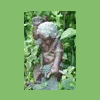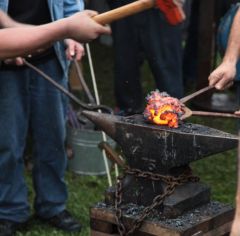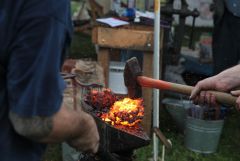-
Posts
162 -
Joined
-
Last visited
Content Type
Profiles
Forums
Articles
Gallery
Downloads
Events
Everything posted by D-ski
-

22nd Annual BGCM Blacksmith Days
D-ski replied to D-ski's topic in Blacksmith Guild of Central Maryland
Matt, We open the gates at about 8am. The demos start at about 9am. Mark Aspery will be demonstrating in one tent, Glenn Horr will be in the othe main tent and there will be a 3rd tent for the knife makers and the impromptu demonstrations by Guild members and others. There will be an area set up for tailgating (aka a blacksmith's flea market). There will be an Iron in the Hat (a type of blacksmith's raffle) with lots of tools, materials and who-knows-what-else. There will also be a silent auction of larger blacksmith tools, but I beleive that that runs through Sunday afternoon. Around 5pm there will be an a live auction of hand forged ironwork. One of John Larson's Iron Kiss hammers will be in tent #3 and will be available for people to try out. John will be there to walk you through how to use it. The iron smelt takes place Friday afternoon. -
Just a reminder that it is less than 2 weeks until the 22nd Annual BGCM Blacksmith Days at the Carroll County Farm Museum, 500 S. Center St. Westminster, MD Friday/Saturday/Sunday, 14/15/16 May 2010. For details, see Reb's announcement here, 3 posts down. Or go to the Guild's webpage: www.bgcmonline.org
-
The April Monthly meeting of the Blacksmith Guild of Central Maryland will be Sunday, April 11th on the grounds of the Carroll County Farm Museum, 500 S. Center St, Westminster, MD 21157. The facility opens up at 9am and we will be there until about 4pm (more or less). Pot-luck lunch at 12 noon Iron-in-the-hat raffle follows lunch Business meeting at about 1pm. Trade Item this month is something including a blade
-
The March Monthly meeting of the Blacksmith Guild of Central Maryland will be Sunday, March, 21st on the grounds of the Carroll County Farm Museum, 500 S. Center St, Westminster, MD 21157. The facility opens up at 9am and we will be there until about 4pm (more or less). If the weather looks threatening, call the HOTLINE: 410-386-9150, in case we have to cancel due to inclement weather. March is time for BGCM's 11th Annual Chili Cook-off. Members bring their favorite mild and spicy chili and compete for “BEST BLACKSMITH CHILI”. If you don't bring a chili dish, bring a side dish to go with chili. Tasting/sampling of the chili starts at noon. Iron-in-the-hat raffle follows lunch Business meeting at about 1pm This month's trade item is something with that includes a dragon
-
The February Monthly meeting of the Blacksmith Guild of Central Maryland will be Sunday, February, 21st on the grounds of the Carroll County Farm Museum, 500 S. Center St, Westminster, MD 21157. The facility opens up at 9am and we will be there until about 4pm (more or less). If the weather looks threatening, call the HOTLINE: 410-386-9150, in case we have to cancel due to inclement weather. Pot-luck lunch at 12 noon Iron-in-the-hat raffle follows lunch Business meeting at about 1pm This month's trade item is something with a twist
-

easy-good looking projects
D-ski replied to irontwister's topic in Blacksmithing, General Discussion
Here is the book that I recemmend to beginner's once they are at the stage you describe: 101 METAL PROJECTS FOR THE NOVICE BLACKSMITH: A “How-To” Shop Manual For Beginners Originally self-published by Al Cannella, 1995 Now available through Poor Boy Blacksmith Tools, an EBay store on the Internet. THe book includes fairly detailed instructions for making a wide variety of items, bbq forks, candle sticks, door pull, tirvets, snakes, plant hooks, etc. I especially like the book becuase he introduces you to making various tools and jigs and then there are projects that uses that tool or jig. For example: how to make an anvil saddle hardy and then use that saddle hardy when making a fork. I also like the fact that he includes precise sizes of the particular stock to use. Many beginner's when they are starting off cannot look at a finished project and extrapolate back to what type of stock to start with and how much to use. -
There is a time and a place for both "eyeballing" and for doing the math. I do a lot with constant volume forging. If I am taking 5/8" square down to 5/16" round, how much 5/8" do I need to start with to get 5" of the 5/16"? I have charts that tell me the number of cubic inches of steel in 1 inch of the various stocks that I routinely use. I also keep a small calculator in the shop to help with these calculations. You can also work with weight. If you know the weight of the final object, you can divide that by the weight of a cubic inch of steel. Once you know that figure, you can translate it into how many inches of stock you need. True you could get the same answer through trial and error, but using math gets you inside the right ball park a lot quicker. If you have been reading the Mark Aspery books, you will notice that he uses a lot of math to help figure things out. A good example of needing math came up this past weekend at the Gichner Memorial Hammer-In. If you are going to submit a ring to the upcoming ABANA CONFERENCE, the ring needs to be made from 1/4" by 1" and the diameter needs to be 10", how much stock do you need to start with?? Formulas and a calculator are just another tool in the toolbox.
-
The January Monthly meeting of the Blacksmith Guild of Central Maryland will be Sunday, January 17th on the grounds of the Carroll County Farm Museum, 500 S. Center St, Westminster, MD 21157. The facility opens up at 9am and we will be there until about 4pm (more or less). At 10am, Ray Neubauer will demonstrate making a fairly simple, straight forward pair of bolt tongs. Pot-luck lunch at 12 noon Iron-in-the-hat raffle follows lunch Business meeting at about 1pm This month's trade item is something with a heart If the weather looks threatening, call the HOTLINE: 410-386-9150, in case we have to cancel due to inclement weather.
-
Newbysmith, what size/type of stock are you starting with??? I like to make my leaves from 3/8" square. Forge a short point, neck-in, back from the point for the lenght of leaf you want and then flatten the leaf part on the diamond. Focus your hammer blows in the center of the mass and try to keep the hammer blows away from the edges. Think of your hammer as a rolling pin, pushing metal out towards the sides. Also to get wider leaves, once you have started to flatten, switch to the peen of the hammer and use the peen to push metal to the sides. Also, I stronly reccemmend the Aspery books. both are outstanding. Read Book 1 to understand hammer control and then Book 2 to learn how to apply that hammer control to leaves.
-
The January Monthly meeting of the Blacksmith Guild of Central Maryland will be Sunday, January 17th on the grounds of the Carroll County Farm Museum, 500 S. Center St, Westminster, MD 21157. The facility opens up at 9am and we will be there until about 4pm (more or less). If the weather looks threatening, call the HOTLINE: 410-386-9150, in case we have to cancel due to inclement weather. Pot-luck lunch at 12 noon Iron-in-the-hat raffle follows lunch Business meeting at about 1pm This month's trade item is something with a heart
-
Irnsrgn, I really like that tool. I have a piece of angle iron, that I use as a "V" block, but I can see that the way you cut away one end of the angle iron makes a very useful tool. Thank you for sharing.
-
I tend to keep my hardy shanks on the short side. That way the tooling can do double duty in the treadle hammer as well as the anvil. I think the limit for the hardy shank in the treadle hammer is about 2" or so, then it would bottom out. (I'd have to go and measure to get an exact length.) The treadle hammer was built in a Clay Spencer directed workshop. I am very happy that both the anvil and the treadle take a 1" square hardy.
-
As always, the December Guild meeting is the Annual Holiday Party to be held this coming Saturday Night, 12 Dec., at the Bear Branch Nature Center. north of Westminster. This is the one time of the year that we do not meet at the Farm Museum. The forging facility will be open this Thursday night, 10 Dec, from 6pm to about 9:30pm for the monthly Open forge. PS: There are still opening in the Forge Welding Class coming up the weekend of 19/20 Dec.
-
This is a topic that I am interested in. By biggest concern is using a finish that will not have any detrimental affects to the person wearing the jewelry since the jewelry comes in contact with the skin. For example anything that has a petroleum base, could that be a problem??
-
I would recemmend a SCOTCH-BRITE deburring/blending wheel. (For those not familiar with a deburring wheel, it is a wheel made of a hard resinous material with abrasive embedded in the resin. It usually comes in medium and fine grades) I use mine a lot to finish punches and chisels, dress hammer faces, etc. A big plus compared to a stone wheel is it does not leave scratches in the metal.
-
There are still openings in the Forge Welding class, 9am to 5pm, Saturday/Sunday, 19/20 December, 2009. Bill Clemens is the instructor. He will lead the students through a series of different welds. Starting with the most basic and working up from there. In the process of learning to weld the students will: weld a chain link; make a flux spoon; and weld a ring onto a shaft to form a faceted cube; among other things. The class fee is $175. Prerequisites: 16 years of age and BS-101, or equivalent skills: fire management in a coal forge; basic hammer skills; familiarity with using tongs. Each student will have his/her own forging station with a coal forge, 167 lb double horn anvil and basic forging tools. Class is limited to 8 students. To sign up for the class contact Emma Beaver at the Carroll County Farm Museum, 410-386-3886, Mondays/Wednesdays/Thursdays. The Farm Museum can now take credit card payments over the phone. The class is held on the grounds of the Carroll County Farm Museum, 500 S. Center St., Westminster, MD 21157.
-
The November Monthly meeting of the Blacksmith Guild of Central Maryland will be Sunday, November 15th on the grounds of the Carroll County Farm Museum, 500 S. Center St, Westminster, MD 21157. The facility opens up at 9am and we will be there until about 4pm (more or less). Pot-luck lunch at 12 noon Iron-in-the-hat raffle follows lunch Business meeting at about 1pm including election of Directors for the Executive Board This months featured demonstrator will be Bill Clemens showing how he is making the small anvil shaped pawns for the chess set.
-
The October monthly meeting of the Blacksmith Guild of Central Maryland will be Sunday October 11th on the grounds of the Carroll County Farm Museum, 500 S. Center St Westminster, MD. The meeting starts at 9am and will run until about 4pm Pot luck lunch at noon followed by an Iron-In-The-Hat Business meeting at 1pm Trade item this month is something made from plate, sheet, or pipe
-
I demonstrate at the Carroll County Farm Museum. When they have events such as the 4th of July Celebration or Fall Harvest days, I will have young boys standing at the railing for hours. I repeat pretty much the same "spiel" over and over as the different groups of people visit the shop. These little boys will remind me when I have left something out: "Hey mister, you forgot to say ............" Or: "Hey mister, you forgot to make a nail". The other visitors in the shop get a kick out of that. I am amazed at how quickly they learn my "spiel" and correct me when I leave something out.
-

Demo for County Schools
D-ski replied to Bad Creek Blacksmith's topic in Blacksmithing, General Discussion
Blacksmithing seems to be a real magnet for the school kids, especially the boys. One thing guaranteed to get a reaction from the kids is when you quench the hot steel in the water. That and putting a twist in the steel. Be prepared for the following 2 questions: can you make a knife?? Do you make swords?? I get these from just about every school group, regardless of the age. Keep your projects really short. The groups are usually on a schedule and can only spend a limited amount of time in the forge before they have to move on to other displays. For the most part I do: nails, leaves and "S" hooks. -
Thomas, thanks for the formula. I will pass it on to our Furnace Master. He seems interested in doing more smelts.
-
Update to the iron smelt that took place at the Mason Dixon Steam and Gas Round Up. The event took place the weekend of 12-13 September. I was not able to attend but was able to get some pictures and a report of how things went. In the pictures below you can see the furnace that they used. It consists of a piece of clay flue liner, wrapped with chicken wire and then smeared with about a 2"-3" layer of refractory cement. (This is not pure refractory cement. The first one they made back in May was just refractory cement and it cracked to pieces when it dried. What you see here is a mixture of refractory cement, portland cement and maybe some sand.) In the 3rd picture, you can see them pulling the iron bloom out of the bottom of the furnace. The last picture shows them consolidating the bloom. The smelt was considered a partial success. The steel tuyere burned up part way through the process, so they ended up with about 7 pounds of iron from 40 pounds of iron ore. (pictures courtesy of BGCM member, Len Brown)


